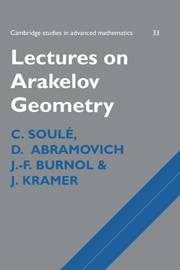Book contents
- Frontmatter
- Contents
- Foreword
- Dedication
- O Introduction
- I Intersection Theory on Regular Schemes
- II Green Currents
- III Arithmetic Chow Groups
- IV Characteristic Classes
- V The Determinant of Laplace Operators
- VI The Determinant of the Cohomology
- VII The Curvature of the Determinant Line Bundle
- VIII The Arithmetic Riemann–Roch–Grothendieck Theorem
- References
- Index
VII - The Curvature of the Determinant Line Bundle
Published online by Cambridge University Press: 14 January 2010
- Frontmatter
- Contents
- Foreword
- Dedication
- O Introduction
- I Intersection Theory on Regular Schemes
- II Green Currents
- III Arithmetic Chow Groups
- IV Characteristic Classes
- V The Determinant of Laplace Operators
- VI The Determinant of the Cohomology
- VII The Curvature of the Determinant Line Bundle
- VIII The Arithmetic Riemann–Roch–Grothendieck Theorem
- References
- Index
Summary
We shall now prove Theorem VI.4 about the curvature of the Quillen metric on the determinant of the cohomology. This result was obtained in [BGS1] after special cases had been proved in the relative dimension one case by Quillen [Q2] and Bismut–Freed [BF]. In fact, for families of curves, this kind of formula was already familiar to physicists, in particular in the Polyakov approach to string theory; see for instance [BK].
A general principle underlying this proof, and also the arithmetic Riemann–Roch–Grothendieck theorem (Theorem VIII.2), is the following. There are three kinds of secondary objects which enter Arakelov geometry: Green currents, Bott–Chern classes, and analytic torsion. But further developments show that these are very similar, and lead to common generalizations. For instance, when proving Theorem VI.4, we shall see that the Ray–Singer analytic torsion is really the Bott–Chern character class of the relative Dolbeault complex. In [BGS2] Green currents and Bott–Chern classes get related, and in [BL] the three objects are simultaneously generalized.
A basic tool for understanding analytic torsion is the concept of superconnection. Following Quillen [Q3] we explain in §1 how it can be used to give new representatives of the Chern character. Similarly, in §2, we give another definition of the Bott–Chern character class of an acyclic complex of hermitian vector bundles. In §3, under the hypotheses of Theorem VI.4, we use superconnections to define a Bott–Chern character class of the relative Dolbeault complex, viewed as a complex of infinite-dimensional bundles on the base.
- Type
- Chapter
- Information
- Lectures on Arakelov Geometry , pp. 140 - 156Publisher: Cambridge University PressPrint publication year: 1992

